How to Start a Backyard Compost Pile
Inside: How to start a backyard compost pile to use up kitchen scraps and make your own fertilizer.
Starting a backyard compost pile is actually a relatively easy thing to do. Don’t be discouraged by all the gurus you see that say you need certain ratios of browns to greens. While these numbers can be helpful (I’ll explain a bit more about it later) they aren’t the end all, be all for making compost.
First, let us understand a bit more about why you should compost. And at the end of the post, you can get a printable compost list so you always know what you can and what you can’t compost.
Affiliate Disclosure: Please note that some of the links in this article may be affiliate links and I may receive a small commission if you purchase something through a link. It will not change your cost. As an Amazon Associate, I earn from qualifying purchases. For more information, see my disclosures page.)
Why Should You Start a Backyard Compost Pile?
When you compost, you are keeping food scraps out of the local landfill. While fruits and veggies will decompose in the landfill, all those nutrients are being wasted.
When you compost at home, you are reducing methane gas. By reducing the amount of food waste that goes into the trash, you are removing odors from your home as well.
Additionally, by making compost at home, you are making valuable fertilizer for your garden. And that may be the very best reason for starting a compost pile!
So whether you grow flowers, vegetables, or just have a few shrubs in your yard, if you have any kind of yard, there really isn’t a good reason not to compost.
(Apartment dwellers, you get a pass on this one, even though there are options for in-home composting for those of you who may be serious about this.)
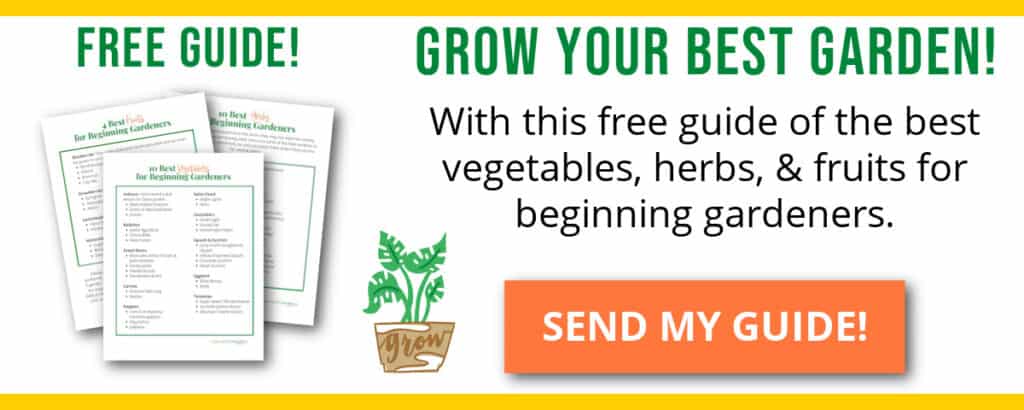
Let’s Talk About Compost Bins and Buckets
If you decide to start composting, you will need just two things – a bucket or container with a lid (to store the kitchen scraps inside the house until you carry them outside) and a compost bin.
For the bucket, you can probably find an old container that you can re-purpose. It can be helpful if it has a lid, especially if you don’t carry it out very often. A lid will keep down odors and eliminate fruit flies that may be attracted to the composting items.
However, one of my boys takes ours out every other day as part of their chores, so there is no smell. If you wanted to purchase something specific for this task, this bucket on Amazon looks super easy to clean. This one even includes a replaceable charcoal filter to help control odors.
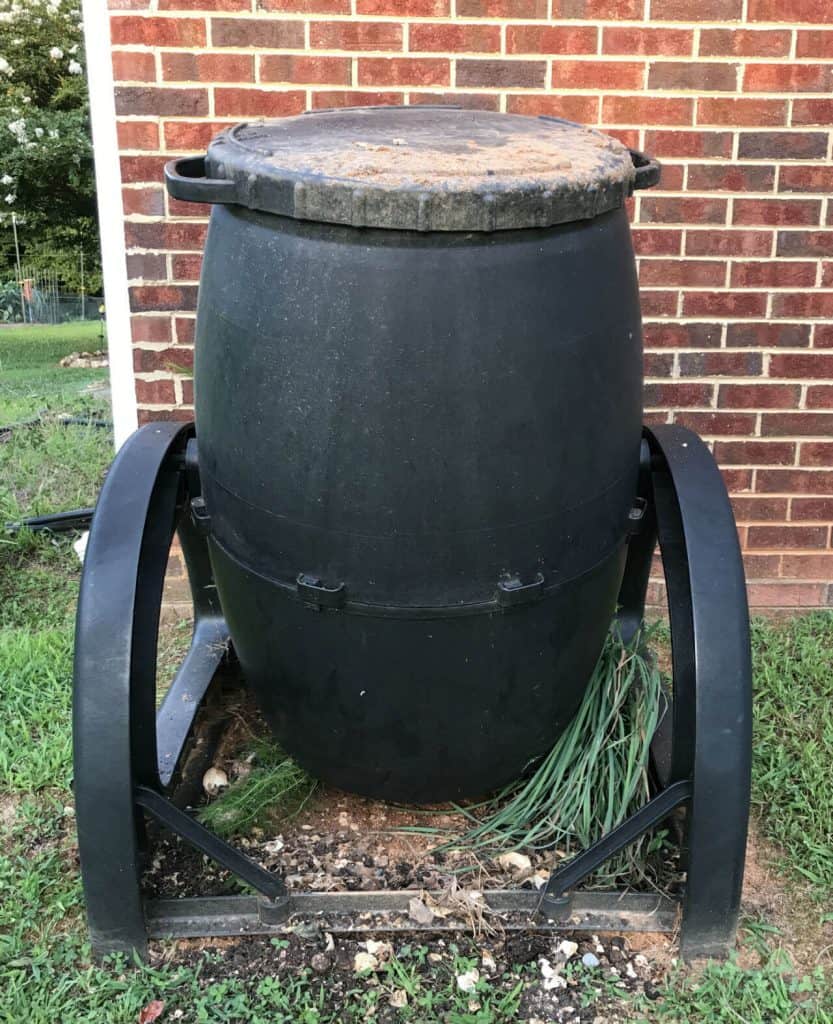
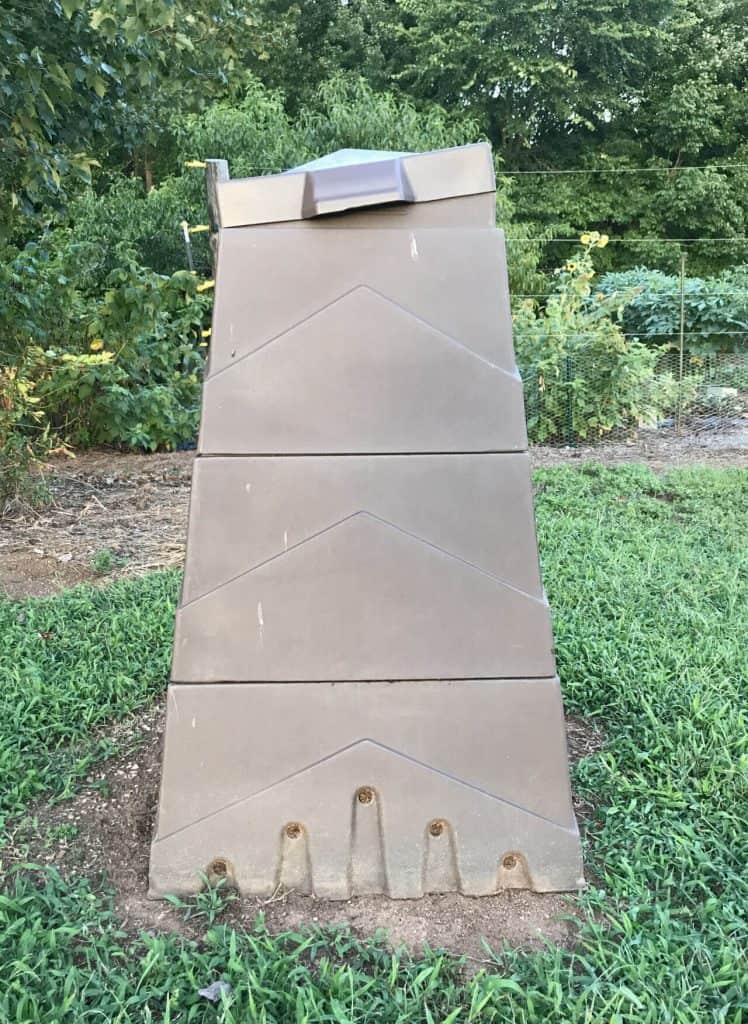
There are also many types of compost bins available on the market today. From tumblers to stand-alone barrels almost everyone should be able to find something that meets their needs. I actually have two composters – a tumbler and a stand-alone unit.
And if you don’t want to go to that expense, there are tutorials on composting directly in the ground. Called pit or trench composting, you just bury the scraps in a hole and let nature take its course.
Where to Put Your Compost Bin?
Once you’ve decided on what type of compost bin you want, you need to decide where to put it. I recommend putting it somewhere that it is easy to access but not against the side of your house.
Occasionally, if you get the ratio of browns and greens off (see below) your compost pile may develop an odor. This happens most often in the summer when it is hot and you tend to have more green vegetable scraps than dead leaves and other carbon-rich materials.
If you can, locate your compost bin in the sun. The sun will allow the compost to heat up quicker and break the materials down faster.
The 4 Elements of Successful Compost
There are really only 4 things you need for successful compost:
- water
- oxygen
- nitrogen
- carbon
The nitrogen comes from what is commonly referred to as green material and the carbon comes from brown material. (More details below.) A successful compost pile will be moist from water, but not too soggy or it can create odors.
Decomposing material also needs oxygen to complete the process of breaking down. A compost pile that gets too densely packed will not decay as quickly as one with sufficient oxygen.
Greens & Browns?
Most composting tutorials will talk about “greens” and “browns.” Greens are plant materials such as kitchen scraps and grass that are rich in nitrogen. Browns consist of dried leaves and newspapers that are carbon-rich.
An ideal ratio is 1 part greens to 3 part browns. However, as long as your backyard compost pile stays moist and aerated, it will decompose.
Think of the leaves in the forest and how rich the soil is underneath all those trees. That’s from the leaves decomposing over time. There is no special “formula” for that compost.
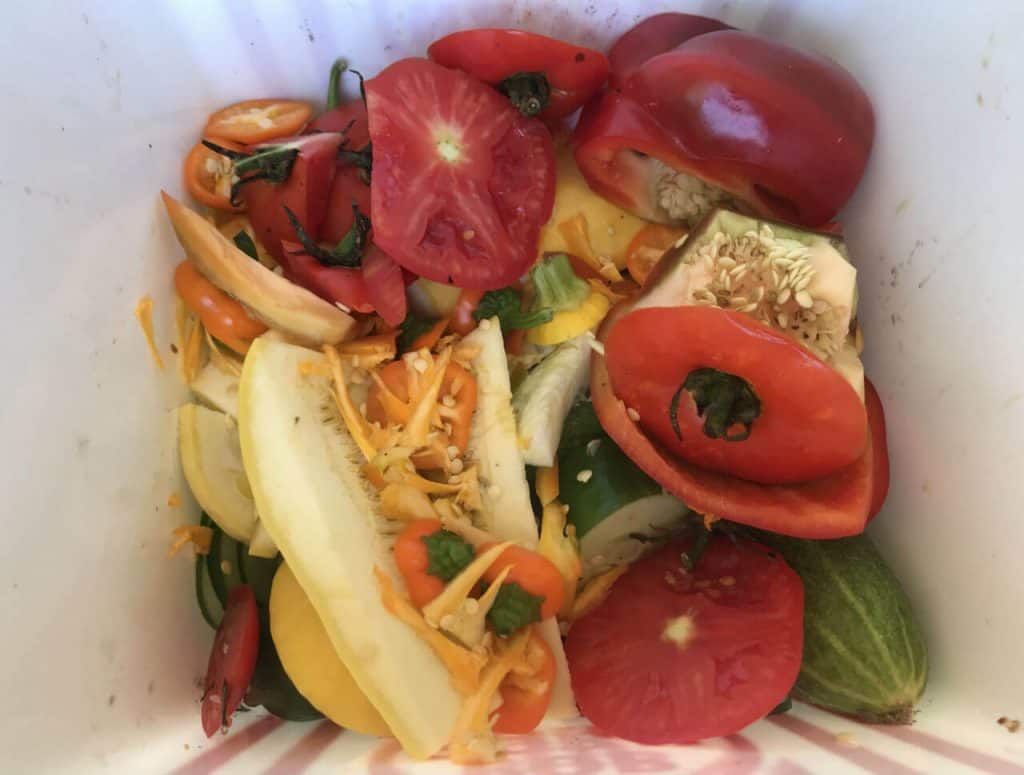
So What Can You Put in a Backyard Compost Pile?
The process of making compost uses organic matter to make rich soil. You can’t add any non-organic matter and expect it to break down.
“Greens”
- fruit scraps – banana peels, strawberry tops, etc.
- vegetable scraps – onion skins, vegetable peels, etc.
- coffee grounds
- tea bags
- eggshells
- weed-free grass clippings and plant trimmings
“Browns”
- dry leaves
- wood shavings or chips – no treated wood
- shredded newspaper
- hay or straw
- cardboard
- ashes from a fireplace or a fire pit
A few things to note: Smaller pieces decompose faster, so if you throw in a huge chunk of watermelon, it will take longer to turn into compost. (But don’t worry, it eventually will still decompose.)
Also, your compost pile does need moisture to turn scraps and yard waste into compost. Usually, as long as you have enough vegetable scraps, you won’t have any problems here, but it is worth mentioning. If you add too many browns at one time, you may need to water the pile to help it along.
If your compost starts to smell, you most likely have too many green materials (kitchen scraps) and not enough browns. The easiest way to remedy this is to add some additional leaves or shredded newspaper.
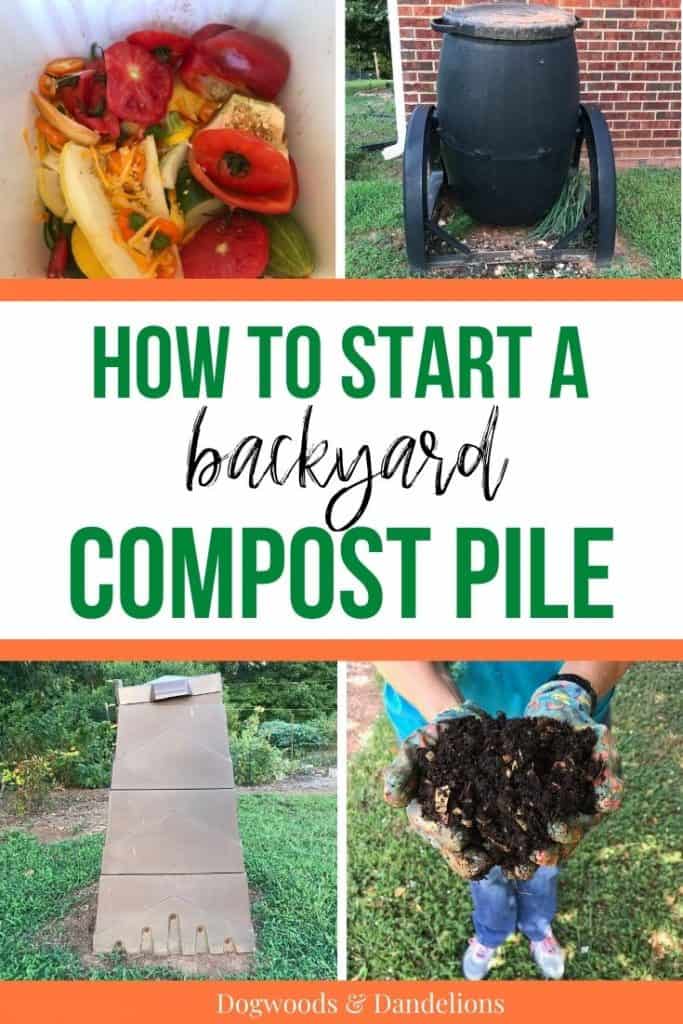
What Not to Put in a Compost Pile
There are a few things you shouldn’t compost:
- any type of meat or animal products
- oil or grease
- fats
- dairy products
- diseased or bug-infested plants
- pet waste
- any non-organic material like plastic bags
Not only will these items cause your compost to stink, they will also attract rodents and other nighttime critters that will dig through your backyard compost pile looking for the meat.
And if you compost diseased plants or bug-infested plants, the diseases and bugs can survive the composting process and be even more prolific the following year.
There are also a few things that can be composted but that I personally have chosen not to include. I don’t add peach pits or corn cobs to my backyard compost pile since they seem to take forever to break down.
I still have peach pits in my garden from compost I made years ago. They aren’t hurting anything but it can be annoying to dig up a peach pit when I am planting something. (They are hard!)
Can You Compost Citrus Peels?
A common question I get is can you compost citrus peels? There has been a huge debate over this in recent years.
The peels from citrus fruits like lemon peels, lime peels, grapefruit peels, and orange peels CAN be composted. While they do take a long time to break down, cutting them into small pieces will help them compost faster.
And some people fear that since citrus oils are used in pesticides, they will harm their garden. However, the oils will break down quickly when exposed to the heat of a compost pile, so by the time you add the resulting compost mix to your garden, the natural chemicals will have broken down.
What About Composting Paper Products?
There is also much debate about composting paper products such as paper plates and paper towels. If there isn’t a large amount of oil in or on these products, they will compost just fine.
The same goes for pizza boxes. Since most pizza boxes are just cardboard boxes, if they aren’t extremely greasy, they can be a good thing to add to the compost pile.
Cardboard has a high carbon content so it will be considered a “brown” ingredient and can help to balance the nitrogen as everything decomposes. I do recommend cutting up the cardboard into smaller pieces first.
How to Speed Up Decomposition
If you want to speed up the composting process, you can add a bit of dirt from your yard or some organic fertilizer. Blood meal or alfalfa meal make great choices.
You can also purchase a product called compost accelerator or activator. A compost accelerator typically contains a harmless microorganism that helps to speed up the composting process.
Turning the compost regularly (at least weekly) will also help improve the rate of decomposition. This allows air to get to other areas of the compost. If you have a bin, not a compost tumbler, you can use a pitchfork to turn the compost.
Alternatively, there are special tools on the market that you can purchase to help turn the compost. These are particularly helpful in smaller compost bins where it can be hard to maneuver a pitchfork.
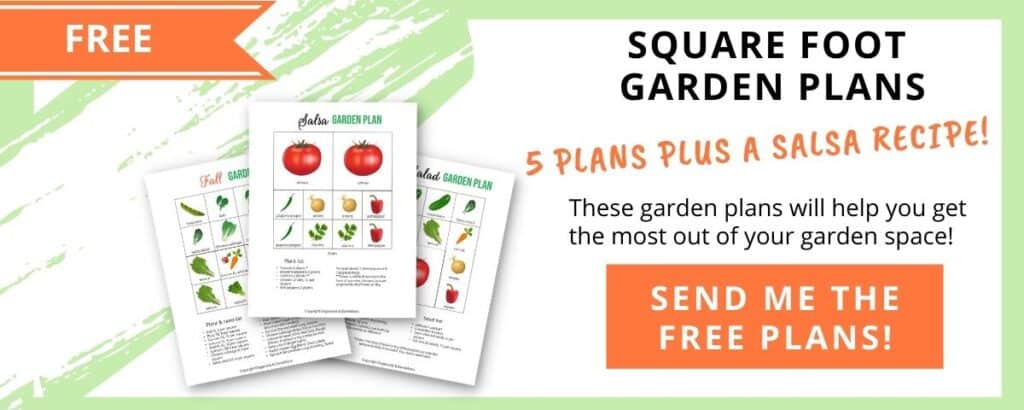
How to Maintain Your Backyard Compost Pile
Maintaining a backyard compost pile doesn’t require much time or effort. The compost ingredients will decompose without any help. However, to speed things up, you should stir your compost heap occasionally. If you have added lots of brown ingredients, you may need to water it every so often as well.
Keep adding to the compost bin as you get additional kitchen scraps, adding leaves and other brown materials as needed.
The best way to do this is to save some leaves in the fall and store them separately from your home compost pile. As you add a layer of green scraps to the compost, top it off with some leaves. In this way, they are keeping the ratio of greens and browns relatively stable.
How Do You Know When Your Compost is Ready?
You’ll know your compost is ready when it looks like black or brown soil. The finished compost will have an earthy smell to it.
There may be bits of vegetables or pieces of eggshell remaining in the finished compost. However, it is still fine to use.
The picture below shows what finished compost looks like. Your compost may vary in color depending on what you add to it.
Your compost also may not have as many eggshells in it as mine does. We raise backyard chickens so we have quite a few eggshells to add to our compost pile.
How to Use Your Backyard Compost
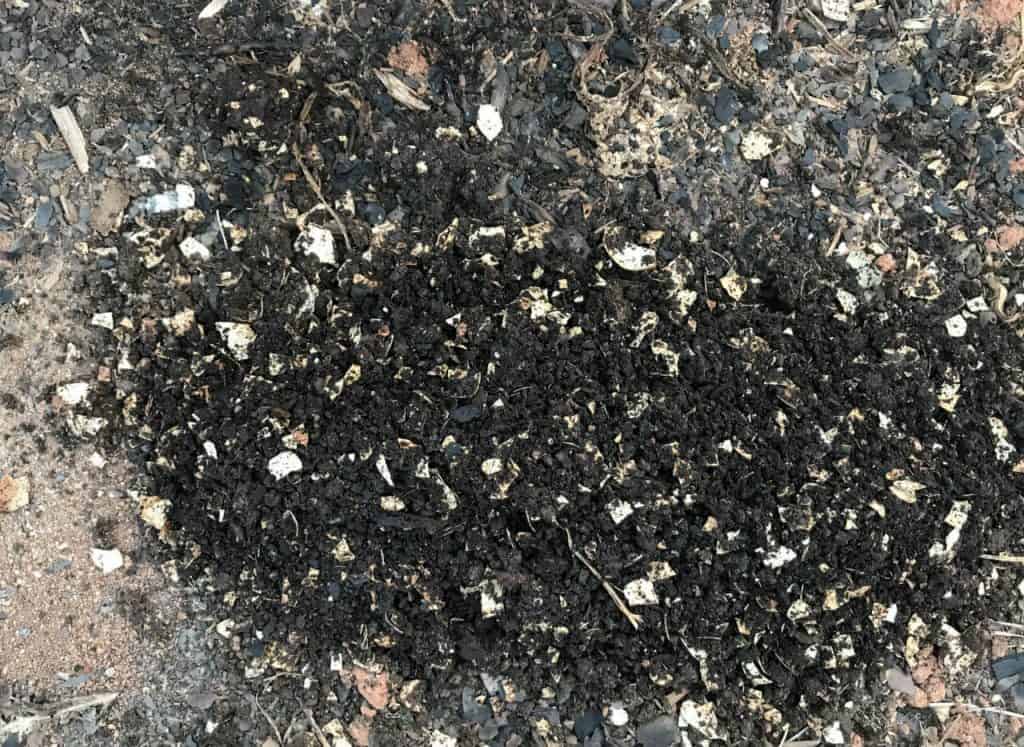
When you are ready to use your compost you have two options: Sift the compost or start a new compost pile.
The easiest way is about 3 months before you want to use your compost, stop adding to that pile, and start a new one. Keep stirring the old pile until it is finished.
Keep in mind that what starts out as a mountain of debris will break down to just a small amount of compost.
The other option is to use a screen to sift out the veggie scraps and leaves that have not finished composting. This is definitely the more time-consuming of the two options. But if you only have room for one compost bin, this allows you to “harvest” some compost while the rest decomposes.
Once you have your finished compost you can apply it to your garden at any time. Compost doesn’t burn plants as other fertilizers can.
You can add some to your garden in the winter if you have a nice day or turn some into the soil in the spring before you plant. Making your own compost and adding it to your vegetable gardens is a great way to improve soil quality.
Add small amounts of compost to the planting holes when you plant your seedlings. Sprinkle it around your existing vegetable plants or pile it on thick. No matter how you apply it, your garden will be thankful, and it’s a great way to keep organic waste out of the landfill.
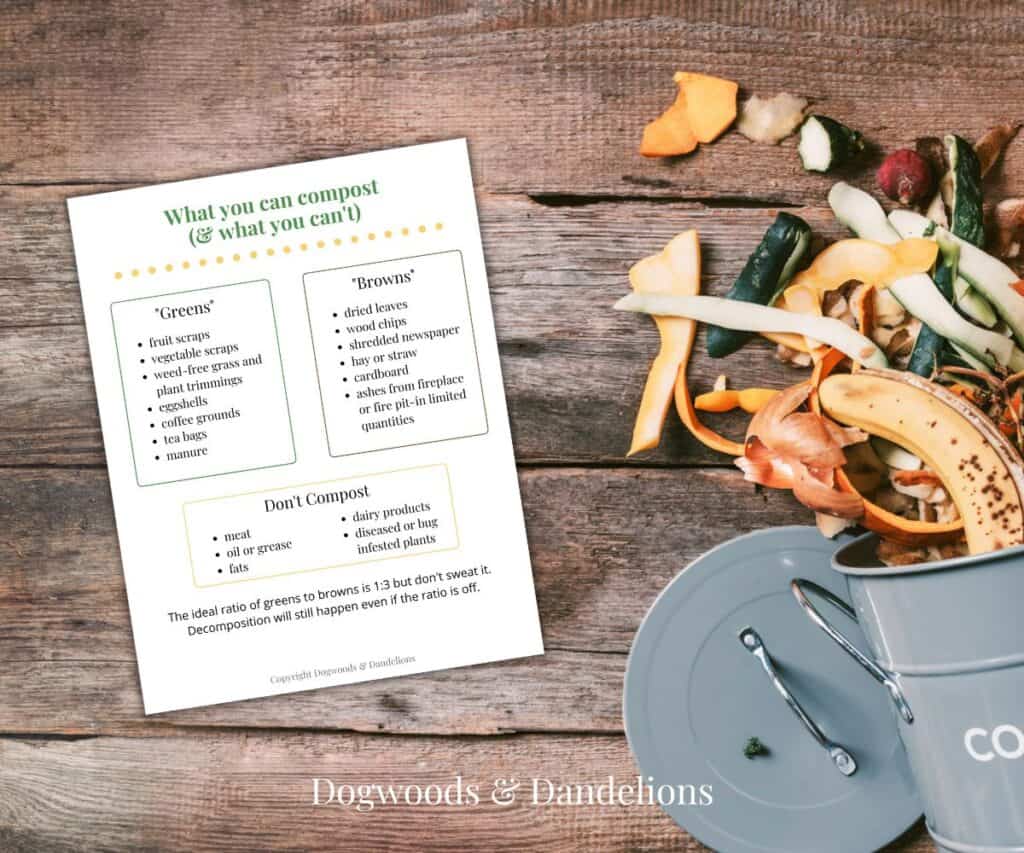
You can get your own copy of this compost printable by signing up for my weekly newsletter. You will be sent the password to my Resource Library where you can download it from the Gardening Printables section.
Related Posts
- Essential Tools for Beginning Gardeners
- How to Attract More Pollinators to Your Garden
- Types of Mulch to Use in Your Garden

Meet Julie
I’m a farm girl born and bred in North Carolina. I’ve been growing a vegetable garden for over 20 years (and helping my Mom grow hers even longer). I’ve been raising chickens in my bathtub and backyard for 12+ years. I believe that homegrown food can be made simple. Let’s get started.
Want to save this post for later? You can pin it to Pinterest right here.

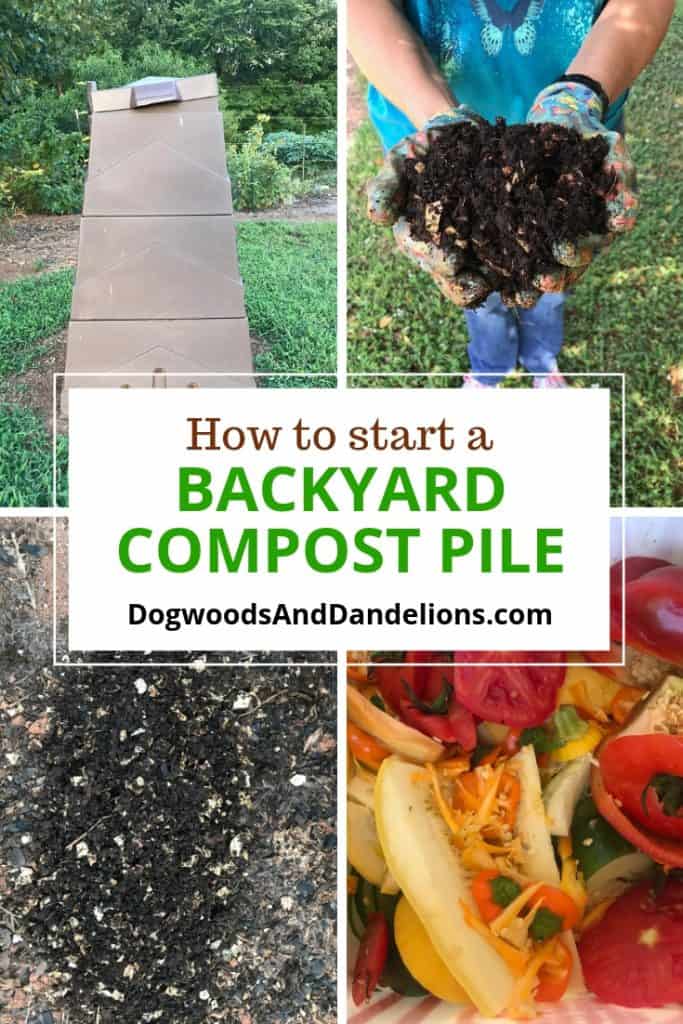
Can I use paper that I have used in my printer, shred it and put it in my compost pile that I’m going to start.
Yes, I use shredded paper all the time!
Very helpful thank you. I’m doing my first compost pile and I needed to know when to stop adding so it so its ready by late May for spring planting. Gotta stop today to give it 3 months.
I’m glad you found the composting information helpful.Thanks for visiting.